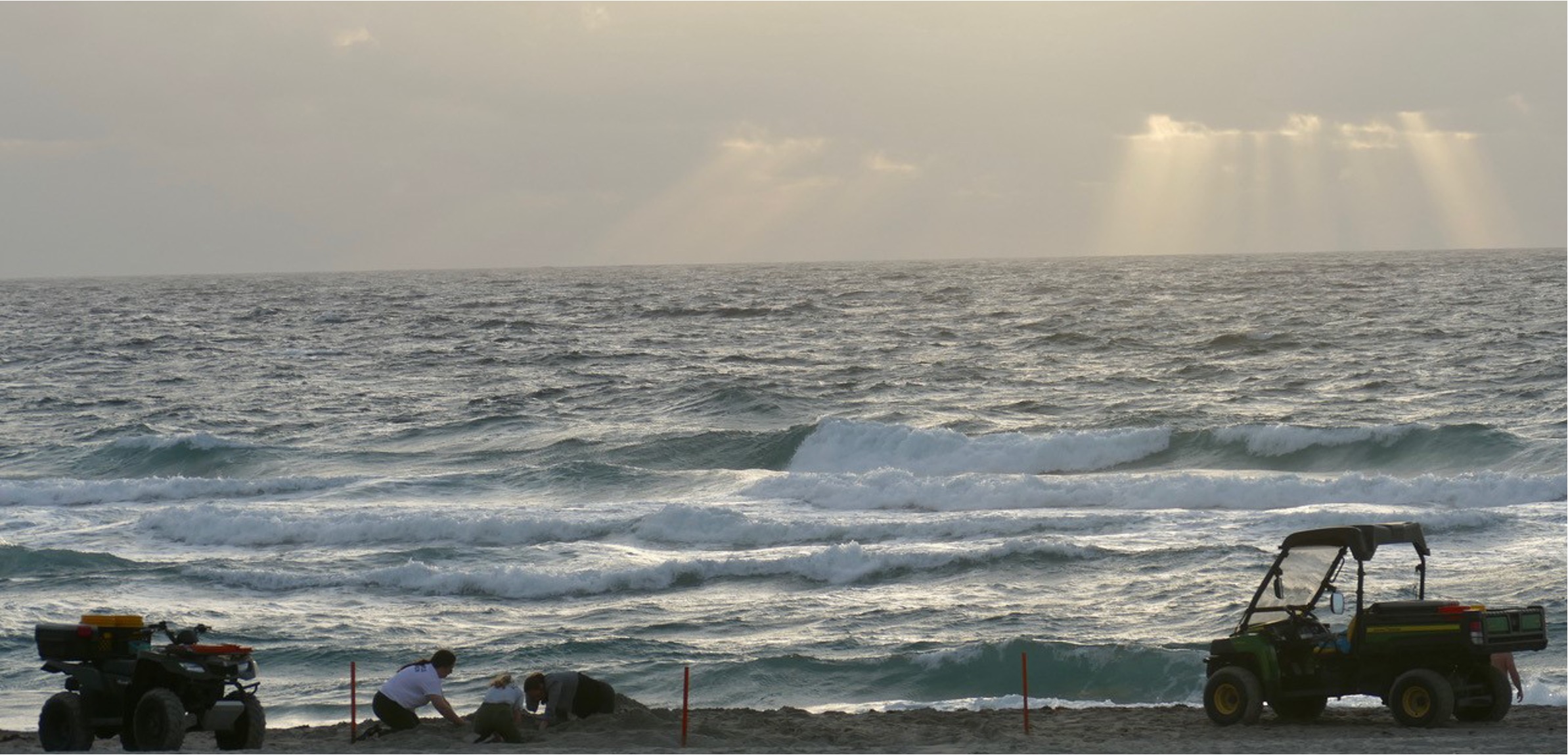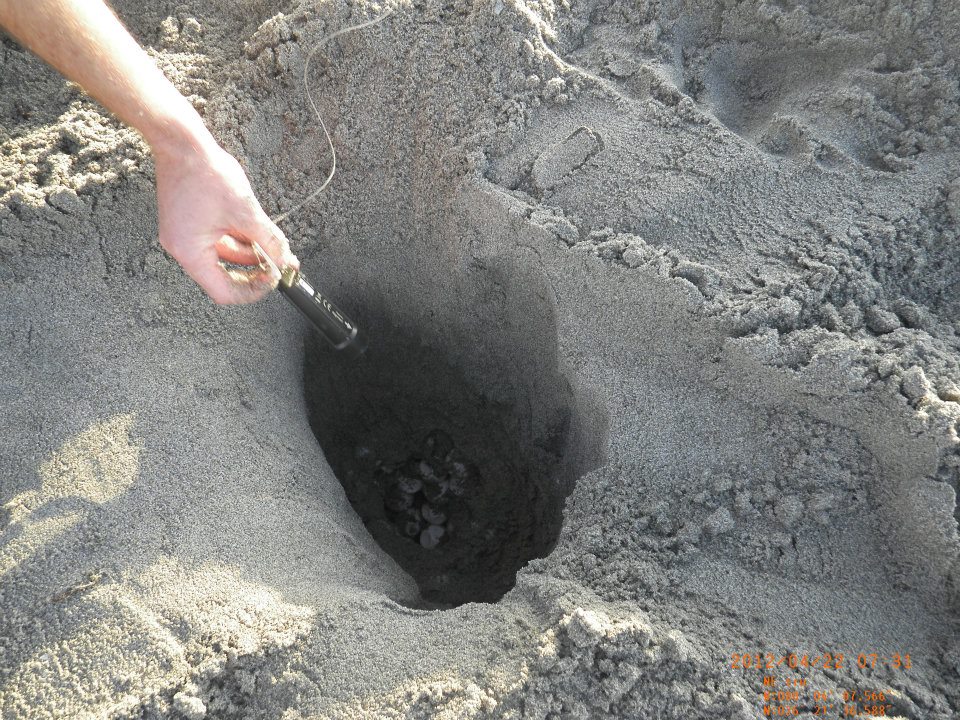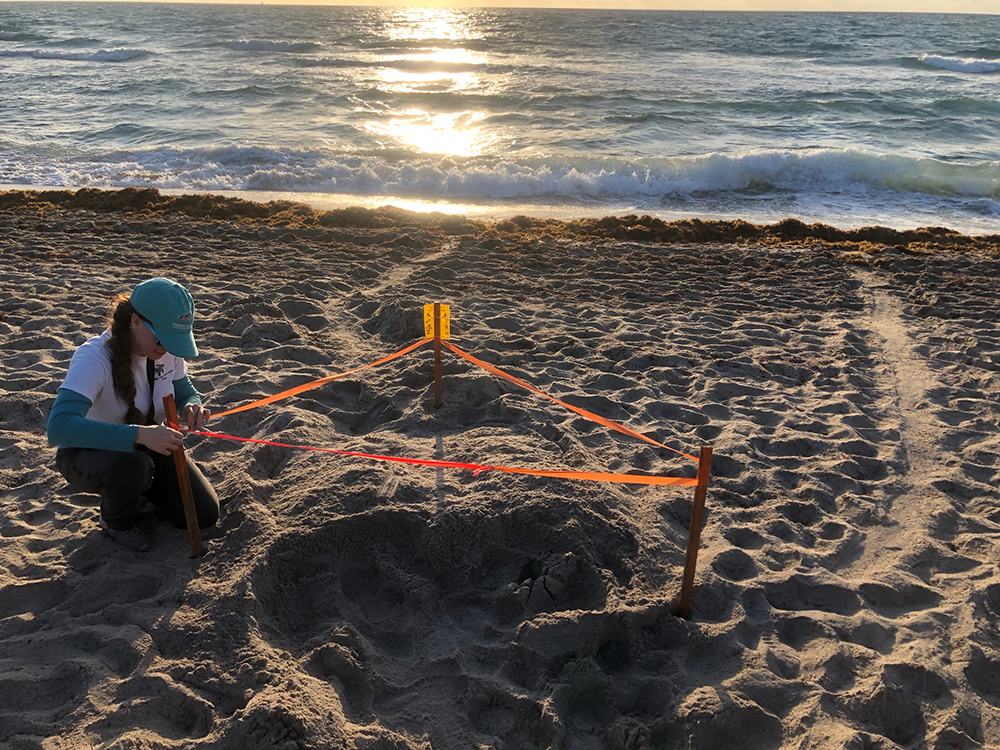
Author: Alex Hoey
Date: June 21, 2024
If you have ever spent a spring or summer day on the beaches of Boca Raton, Florida then you’re familiar with the orange stakes and tape denoting the locations of the hundreds of sea turtle nests. These nests are marked and monitored by the Gumbo Limbo Nature Center (GLNC) conservation department, a neighbor and partner of the FAU Marine Lab. The conservation team—including coordinator David Anderson, assistant coordinator Rebecca Germany, and several part-time Marine Turtle Specialists (MTS)— aid our research at the FAU Marine Lab, helping us to conduct the fieldwork essential to understanding how, for example, temperature affects sea turtles. As a FAU Marine Lab student and a Gumbo Limbo Nature Center MTS, I am pleased to give readers insight into the daily responsibilities of the conservation team and the important partnership between our two organizations!
First and foremost, the conservation team is solely responsible for the daily nesting survey of the 5 miles of Boca Raton beaches. We meet before dawn, head to the beach in John Deer® Gator™ Utility Vehicles and All-terrain vehicles (ATVs) while most people are still asleep. Driving along the previous night’s high tide line, we spot fresh sea turtle tracks from our vehicles. Each turtle has one track from the ocean, moving up the beach toward the dune, and another heading back to the ocean. From these tracks, along with other clues in the sand, we can identify the species of turtle, whether she successfully laid eggs, and approximately where the eggs might be located. If she did not lay eggs—even if she got as far as digging an egg chamber before abandoning it—the emergence is considered a “false crawl.” Each and every sea turtle track on the beach is recorded and data are collected, whether the individual nested or not. Data collection includes the species of turtle, the distance from the apex of the crawl to the dune and average high tide line, photos specifying the characteristics of the nesting location, and the GPS coordinates of the crawl.

When we find a successful nest, the partnership between the GLNC conservation team and the FAU Marine Lab truly shines, as a random selection of these nests become research nests. Primarily, these nests become part of the ongoing sex ratio study by the lab to determine the ratio of female to male sea turtle hatchlings produced on these beaches; that ratio is determined by the temperatures in the egg chamber. To use the nest for research, the GLNC conservation team inserts a temperature datalogger (Think of it as a weather-proof recording thermometer!) within the nest. We dig in the sand in the approximate location of the eggs, which can be determined based on the fluffy mound of sand that the female throws behind her to disguise the location of each nest. Eggs can be found anywhere from 1.5 - 3.0 feet deep, and the sand above the nest tends to be softer, giving an indication that we’re digging in the right place. Once the egg chamber is found, we count and remove about one third of the eggs in the nest (the “clutch”), place the datalogger in the middle of the egg mass, and return the removed eggs to the nest, all with the utmost care. The nest is then left undisturbed by human observers for the remainder of the incubation period. The datalogger will record the internal temperature of the nest every 15 minutes throughout the entire incubation period, which can range anywhere between 45-80 days, depending upon both environmental and incubation temperatures, as well as the sea turtle species.
Unfortunately, nests sometimes may be disturbed by factors beyond our control, such as high tides that inundate the nests or by predators. Therefore, on our return to the nature center we check every nest on the beach for signs of predation, water disturbance, and hatchling activity. Several species of nest predators affect sea turtle eggs and hatchlings, including birds such as crows and night herons, ghost crabs, raccoons, and skunks. However, the most prevalent and destructive predators are foxes and recently, coyotes. The amount of damage done by a predator will determine what measures we take. In a minimal predation event, where an animal dug in the nest but didn’t reach the eggs or hatchlings, we sprinkle habanero pepper powder on the sand above the nest. This deters mammalian predators but does no harm to the sea turtle eggs or hatchlings. If the predator digs down far enough to reach the eggs, we place a flat metal screen over the nest, with holes big enough to allow emergent hatchlings to crawl through but prevent the predator from reaching the remaining eggs or hatchlings once again.
A particularly interesting (and smelly!) part of our day on the beach involves nest inventories. When tracks on the sand surface indicate that the hatchlings have emerged from the nest — most often in the middle of the night — we mark the nest for excavation 3 days later. This way, any hatchlings that might still be inside the nest have a chance to emerge naturally on subsequent evenings. But after 3 days, the team excavates the nest by digging downward to inventory its contents: the shells of hatched eggs, unhatched eggs, and any hatchlings remaining in the nest, whether dead or alive. Those hatchlings that remain alive (“stragglers”) are released that evening, giving them a second chance to craw to the ocean! If the inventoried nest is a research nest, all the hatchlings are captured after they emerge and brought back to the FAU Marine Lab where a subset are raised to determine whether they are male or female; the rest of the clutch is released that evening. Eventually, the hatchlings reared in the lab are sexed and then taken well offshore for release in the Gulf Stream Current.
Upon our return in the late morning to the nature center office, coffee or ice pops are consumed enthusiastically by the survey crew while we sort and record the daily survey data and photos, ensuring accuracy. Our beach data are not only used for FAU Marine Lab projects—they also are reported to Florida Fish and Wildlife Conservation Commission for long-term population monitoring and used to understand the effects of artificial light pollution, among other things! The importance and utility of the collected daily beach data cannot be overstated as it provides insights into how well marine turtle populations are recovering and what factors are affecting those conservation efforts. Through the FAU Marine Lab’s partnership with the GLNC conservation team, each organization benefits and we also develop a more accurate and well-rounded picture of the sea turtle population nesting on the beaches at Boca Raton.
All activities conducted under Marine Turtle Permit #041and #073
